new posts in all blogs
Viewing: Blog Posts Tagged with: science books, Most Recent at Top [Help]
Results 1 - 25 of 41
How to use this Page
You are viewing the most recent posts tagged with the words: science books in the JacketFlap blog reader. What is a tag? Think of a tag as a keyword or category label. Tags can both help you find posts on JacketFlap.com as well as provide an easy way for you to "remember" and classify posts for later recall. Try adding a tag yourself by clicking "Add a tag" below a post's header. Scroll down through the list of Recent Posts in the left column and click on a post title that sounds interesting. You can view all posts from a specific blog by clicking the Blog name in the right column, or you can click a 'More Posts from this Blog' link in any individual post.
 There were no science books on the YALSA Award for Excellence in Nonfiction for 2016. Nor in 2015. Nor 2014. Bomb in 2013 was sort of a science book, so we’ll count that. And Moonbird that year certainly was. Yet it’s often surprising how consistently science and nature get overlooked when they’re handing out awards for nonfiction. According to my sources, science writers are complaining about this fact, and with good reason. When you create an award for nonfiction and then hand it consistently to biographies, you are, however unintentionally, sending a message.
There were no science books on the YALSA Award for Excellence in Nonfiction for 2016. Nor in 2015. Nor 2014. Bomb in 2013 was sort of a science book, so we’ll count that. And Moonbird that year certainly was. Yet it’s often surprising how consistently science and nature get overlooked when they’re handing out awards for nonfiction. According to my sources, science writers are complaining about this fact, and with good reason. When you create an award for nonfiction and then hand it consistently to biographies, you are, however unintentionally, sending a message.
On the children’s side of things the Robert F. Sibert Medal fares a bit better. In 2016 none of the books were science or nature related, but in 2015 we had Neighborhood Sharks and in 2014 Parrots Over Puerto Rico by Susan L. Roth and Cindy Trumbore actually took home the Medal itself with Look Up! Bird-Watching in Your Own Backyard by Annette LeBlanc Cate getting an Honor. You go, Sibert committees!
In their honor, I dedicate today’s list to the lovely science and nonfiction books that were published in 2016 with a hat tip to Melissa Stewart for inspiring me to do this list in the first place.
2016 Science and Nature Books for Kids
FICTION PICTURE BOOKS
Honoring those books willing to add a little science and nature in their mix. Extra points for backmatter.
Ada Twist: Scientist by Andrea Beaty
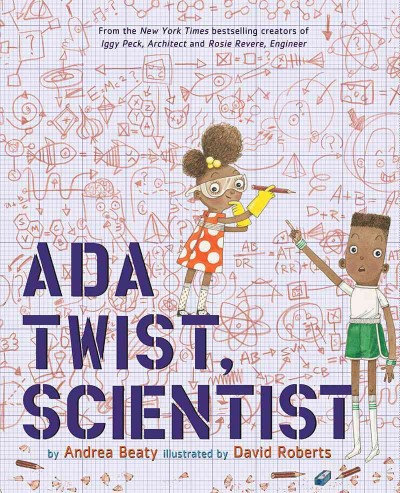
Unless I’m much mistaken, she’s still topping the New York Times bestseller list in the picture book category. I’ll give you some moments to take in the vast implications of this. Pairs particularly well with the upcoming film Hidden Figures.
Baby Loves: Aerospace Engineering!/Quarks! by Ruth Spiro, ill. Irene Chan

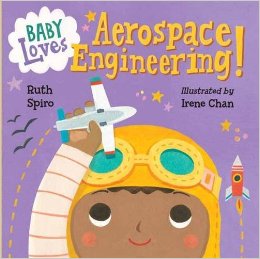
I defended this to you when I put it on the board book list, and I’d willingly do so now. Don’t just assume that due to their format these are meant solely for babies. It’s a kitchy idea that yields a lot of plum rewards. Big concepts are broken down for young people. I can get behind that.
Because of an Acorn by Lola M. Schaefer & Adam Schaefer, ill. Frann Preston-Gannon

It’s the ciiiiiiircle of liiiiiife . . . and it mooooooves us alllllllll . . .
Coyote Moon by Maria Gianferrari, ill. Bagram Ibatoulline

Apparently coyotes roam my own neighborhood’s streets in the summer. I’ve never seen them, but I’m willing to believe it. Jaw-droppingly gorgeous with a surprisingly gripping text, this is sort of like a more fictionalized version of the aforementioned Neighborhood Sharks, only this time with coyotes. In hindsight, I should have put this on the readaloud list too. GREAT readalouding.
Faraway Fox by Jolene Thompson, ill. Justin K. Thompson

The book follows a single fox blocked off from its fellows by a highway. Humans construct a tunnel under the road for wildlife and the fox is reunited with its kind. Information appears at the end about the real world tunnels, how they are constructed, and some of the challenges they fact. The art, for the record, is also a real draw here. Luscious.
Follow the Moon Home: A Tale of One Idea, Twenty Kids, and a Hundred Sea Turtles by Philippe Cousteau & Deborah Hopkinson, ill. Meilo So
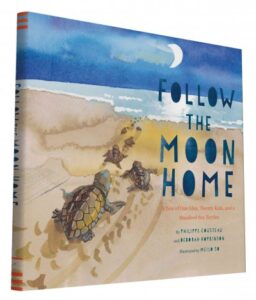
The only Meilo So book out this year? Nope, there’s one coming up later (see if you can guess what it is). Here, a girl attempts to save loggerhead sea turtle babies from man-made light, which means she has to engage in some pretty serious activism. A very cool story, and one I’ve not seen told before.
From Wolf to Woof!: The Story of Dogs by Hudson Talbott

This pairs particularly well with . . .
Grandmother Fish: A Child’s First Book of Evolution by Jonathan Tweet, ill. Karen Lewis

. . . this book. Both cover evolution to a certain extent. This scrappy little Kickstarter title covers ground that few books have on evolution.
Mad Scientist Academy: The Weather Disaster by Matthew McElligott
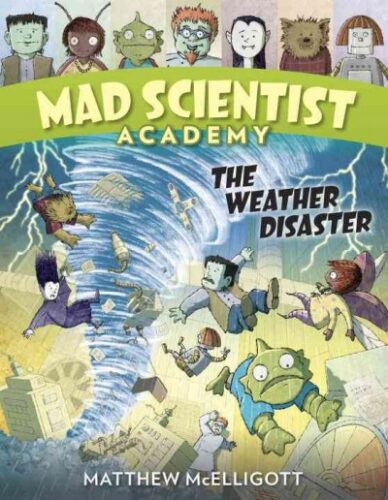
Not a lot of good weather books out this year. This one’s filling a 2016 gap.
Octopus Escapes Again by Laurie Ellen Angus

I’m oddly partial to this adorable book and the creature behind it. Always makes me think of this stranger still video, of course.
Olinguito, from A to Z! / Olinguito, de la A a la Z! by Lulu Delacre
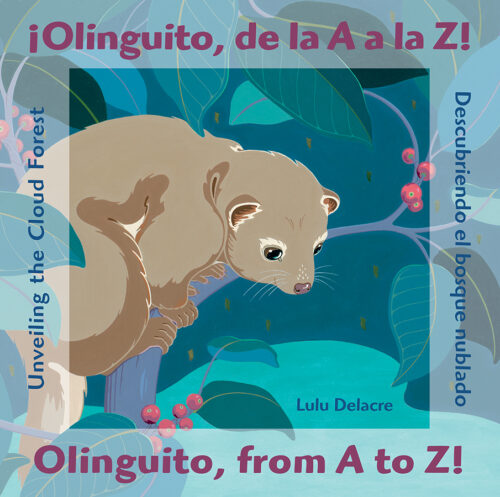
Sure, it’s an alphabet book. Sure it’s bilingual. But it’s actually a really delightful trip into the cloud forest to talk about “discovering” a new animal. Drills home to kids the fact that this is still being done today, barring the destruction of said cloud forest.
Otters Love to Play by Jonathan London, ill. Meilo So

It’s the second Meilo So title on this list today! Hooray! And otters basically just sell themselves. In writing this part of today’s list I just wasted a lot of time watching otters on YouTube for inspiration (have you seen the one of the baby sleeping on its mommy?). In any case, this lives up to its subject matter.
NONFICTION CHILDREN’S BOOKS
Animals by the Numbers: A Book of Infographics by Steve Jenkins

I just recommended this book to a colleague looking for a book to give to a 7-year-old who loves facts and figures and animals too. Couldn’t have come up with anything better! Plus, it’s where I learned that the peregrine falcons that nest on my library every year are the fastest birds in the world.
A Beetle Is Shy by Dianna Hutts Aston, ill. Sylvia Long
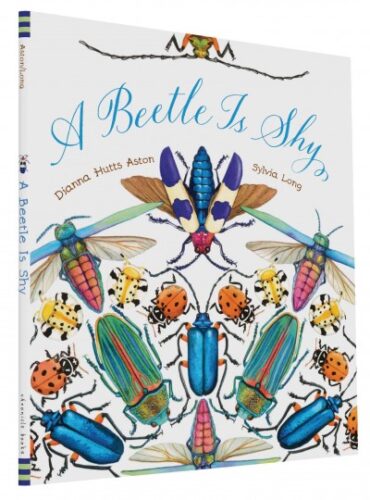
This is a long-standing series but it doesn’t appear to be slowing down in any way, shape, or form. Distinctly fabulous.
The Deadliest Creature in the World by Brena Z. Guiberson, ill. Gennady Spirin
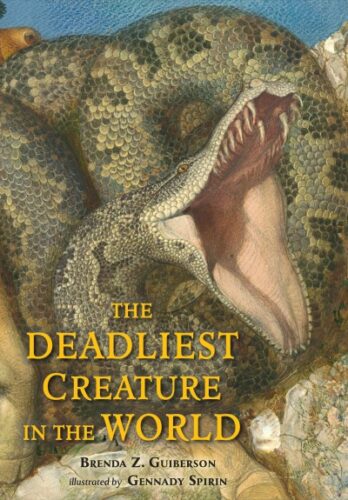
I’m a sucker for a Guiberson/Spirin combo any day of the week. Actually, I’m a sucker for Spirin, period, but his work with Guiberson over the years has never produced a melon. Plus, how do you top that title? Answer: You don’t.
Deep Roots: How Trees Sustain Our Planet by Nikki Tate

I was blown away with this book. Seriously floored. You go into it thinking it’s just another gee-aren’t-trees-great title and what you get instead is this enormously in-depth, serious consideration of how they contribute to the earth. We’ve all heard the statistics on how much oxygen in the atmosphere they produce, but this was the first children’s book I’ve ever read that attempted to explain precisely how their root system works. I’d listened to a RadioLab episode (From Tree to Shining Tree) that explained this and I’m still shocked by the implications. Well done Ms. Tate for filling this book with such pertinent, incredibly up-to-date information!
Dining With Dinosaurs: A Tasty Guide to Mesozoic Munching by Hannah Bonner
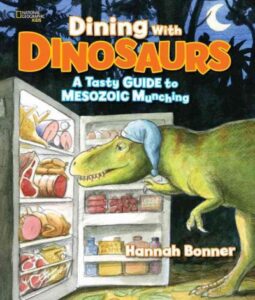
I’m not just sticking this on here because I need a dino title. Trust me, my library shelves are good in that area. But this took a distinctly deep and delightful look at a topic I would have told you had already been covered. Turns out, not so much. A must-add.
Does a Fiddler Crab Fiddle? by Corinne Demas & Artemis Roehrig, ill. John Sandford
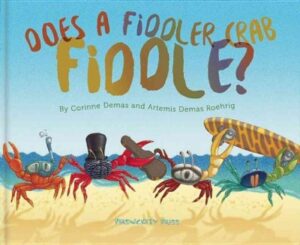
I honestly thought the book was just going to start with fiddler crab and then move on to other animals with evocative names. Nope. Demas and Roehrig are in it for the long haul. The long fiddler crab haul. Good on them!
Feathered Dinosaurs by Brenda Z. Guiberson, ill. William Low
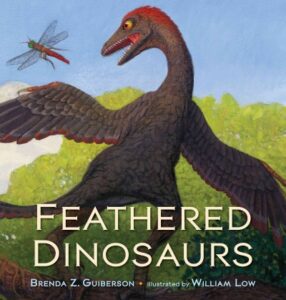
Because you can’t have enough dinosaurs. Or enough Guiberson, for that matter.
Flying Frogs and Walking Fish: Leaping Lemurs, Tumbling Toads, Jet-Propelled Jellyfish, and More Surprising Ways That Animals Move by Steve Jenkins and Robin Page
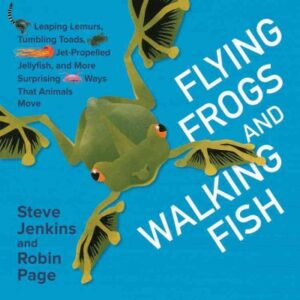
I’d cut that title way way down, but that’s the only thing I’d cut from this highly engaging title (plus it’s always great to see Jenkins and Page working together again).
How Much Does a Ladybug Weigh? by Alison Limentani
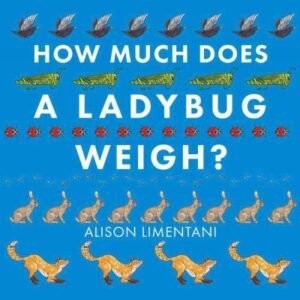
I put this on the math list not too long ago, but it’s also a really interesting, very young, science title. When you consider how much each animal weighs, you find yourself having your assumptions consistently challenged. Math and science = best buds.
I Am NOT a Dinosaur by Will Lach, ill. Jonny Lambert

My college, for whatever reason, owned the skeleton of a giant sloth. I remember seeing it for the first time on display, just utterly baffled by what I was looking at. Sloths were giants once? If you’ve a kid, hand them this book and they’ll be able to know this information far sooner than my sad college-aged self.
If You Are a Kaka, You Eat Doo Doo: And Other Poop Tales from Nature by Sara Martel, ill. Sara Lynn Cramb
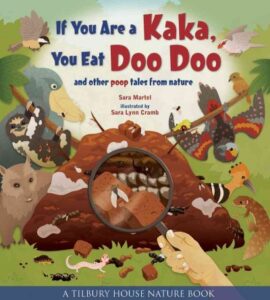
That title’s gonna turn off a bunch of folks right from the start. Maybe that’s not the worst thing, since it really is a book entirely about poop. That said, it’s not gross about it. I mean, there are gross things in it (one word: smearing) but they’re presented in a very matter-of-fact way. If you buy only one poop book this year . . .
My Book of Birds by Geraldo Valerio
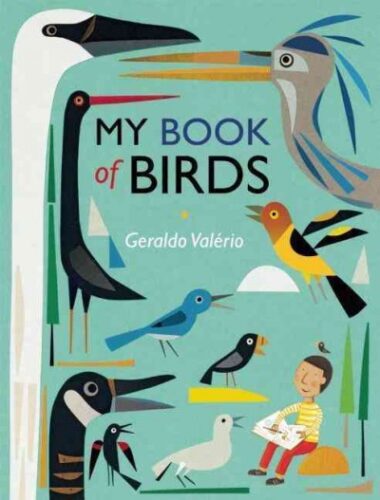
Shockingly lovely from start to finish. A science picture book coffee table book, if you take my meaning.
Natumi Takes the Lead: The True Story of an Orphan Elephant Who Finds Family by Gerry Ellis with Amy Novesky
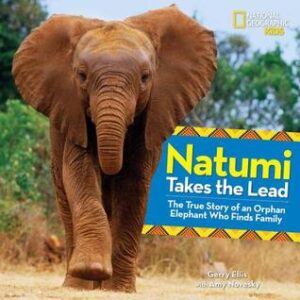
Such a good story, and a good readaloud too. I’d normally avoid any book that traipses this close to anthropomorphism but Gerry and Amy are very careful to place everything in terms true to a baby elephant. Could actually work as a graduation gift picture book as well, come to think of it.
Pink Is for Blobfish: Discovering the World’s Perfectly Pink Animals by Jess Keating, ill. David DeGrand
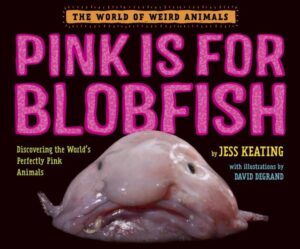
Not solely about the blobfish, alas, but still worth your time thanks to the sheer number of facts packed into these pages.
Plants Can’t Sit Still by Rebecca E. Hirsch, ill. Mia Posada

A cute premise. Shows all the different ways that plants get up and go go go!
The Polar Bear by Jenni Desmond

Though it’s not sourced properly (no backmatter to speak of) this is still a truly gorgeous book. It’s the kind of title you can use to either sate the polar bear needs of a true fans, or lure other readers into adoring.
Prairie Dog Song: The Key to Saving North America’s Grasslands by Susan L. Roth and Cindy Trumbore
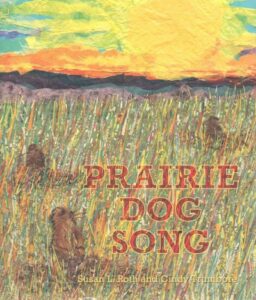
The prairie, its life, its history, and its possible future are all discussed in this beautifully rendered little book.
The Toad by Elise Gravel
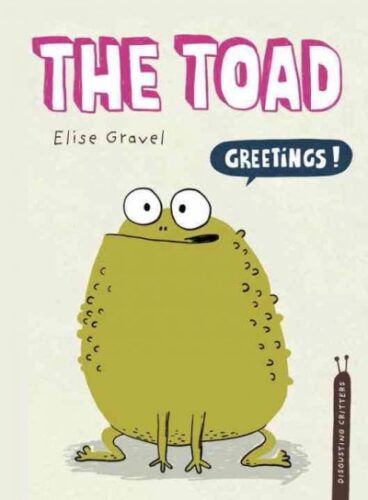
I’m a big fan of all the Gravel series titles. Of the titles out this year, the toad stole my heart. Maybe because I used to catch them in my backyard as a kid. Maybe just because this book’s the funniest.
The Tragic Tale of the Great Auk by Jan Thornhill

I’m a little ashamed to admit that I had no idea what a Great Auk even was before I read this book. Or, for that matter, that they were gone. Sometimes it feels like the passenger pigeon and the dodo get all the press. Poor auks.
Under Earth / Under Water by Aleksandra Mizielinska and Daniel Mizielinski
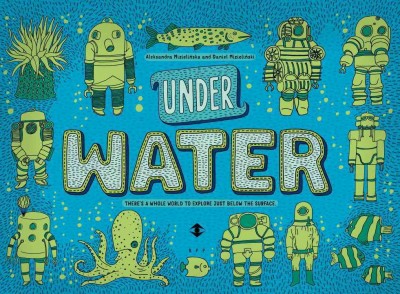
Leave it to the Polish to do something this cool. My kids just dive into this book (no pun intended) since there are so many tiny elements to adore. Again, no backmatter to speak of (European nonfiction titles have that in common) but still awesome. And huge!
What Milly Did: The Remarkable Pioneer of Plastics Recycling by Elise Moser, ill. Scot Ritchie
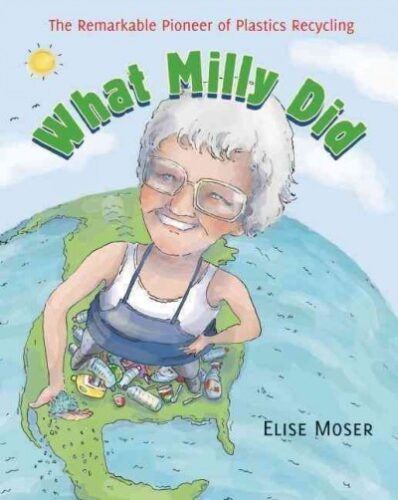
Ever stop to consider the fact that recycling plastics is a relatively new idea? How did it get officially started by vast numbers of cities around the country? A little old woman figured it all out. I love unexpected heroines.
Whoosh! Lonnie Johnson’s Super-Soaking Stream of Inventions by Chris Barton, ill. Don Tate
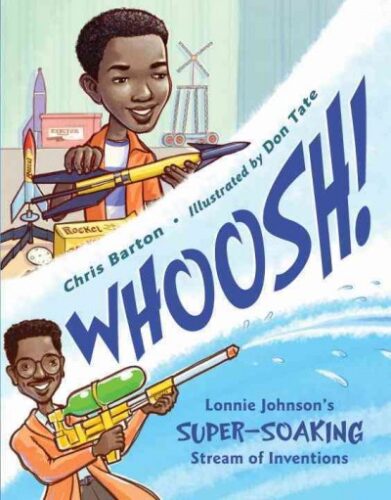
I’m keen on unexpected heroes too. This book is great because it shows that you don’t have to come up with polio vaccine to be considered an inventor. Plus this guy (A) made something cool and (B) is still alive! Once in a while you get a kid in your library who has to check out a bio on someone still alive. Now you’ve an ace in your back pocket.
Whose Eye Am I? by Shelley Rotner

Look them in the eye and tell them you’re not interested in this book. Go on. Tell them.
Interested in the other lists of the month? Here’s the schedule so that you can keep checking back:
December 1 – Board Books
December 2 – Board Book Adaptations
December 3 – Nursery Rhymes
December 4 – Picture Book Readalouds
December 5 – Rhyming Picture Books
December 6 – Alphabet Books
December 7 – Funny Picture Books
December 8 – Calde-Nots
December 9 – Picture Book Reprints
December 10 – Math Picture Books
December 11 – Bilingual Books
December 12 – International Imports
December 13 – Books with a Message
December 14 – Fabulous Photography
December 15 – Fairy Tales / Folktales
December 16 – Oddest Books of the Year
December 17 – Older Picture Books
December 18 – Easy Books
December 19 – Early Chapter Books
December 20 – Graphic Novels
December 21 – Poetry
December 22 – Fictionalized Nonfiction
December 23 – American History
December 24 – Science & Nature Books
December 25 – Transcendent Holiday Titles
December 26 – Unique Biographies
December 27 – Nonfiction Picture Books
December 28 – Nonfiction Chapter Books
December 29 – Novel Reprints
December 30 – Novels
December 31 – Picture Books

If you are like us, shopping is tops on your to-do list this season. Finding the perfect present can be tricky and so here are a few of our favorites that are perfect for the little reader in your family.
Snowy books for a cold winter’s day
Have you read The Mitten more times than you can count? Tuktuk: Tundra Tale by Robin Currie is a fun take on the familiar story.
 As the sun begins to set, arctic animals scurry to prepare for six months of darkness and cold. Tuktuk the collared lemming is almost ready for the long winter night – all he needs is warm fur to line his nest. When one furry kamik (boot) slips off an Inuit driver’s sled, Tuktuk is in luck! But as he drags it home, Putak the polar bear, Aput the arctic fox, and Masak the caribou eye this little lemming’s prize and want it for their own. Can Tuktuk outwit the other animals and convince them that one furry kamik is no good for anyone bigger than a lemming?
As the sun begins to set, arctic animals scurry to prepare for six months of darkness and cold. Tuktuk the collared lemming is almost ready for the long winter night – all he needs is warm fur to line his nest. When one furry kamik (boot) slips off an Inuit driver’s sled, Tuktuk is in luck! But as he drags it home, Putak the polar bear, Aput the arctic fox, and Masak the caribou eye this little lemming’s prize and want it for their own. Can Tuktuk outwit the other animals and convince them that one furry kamik is no good for anyone bigger than a lemming?
When ancient creatures are a favorite, try Wandering Woolly! Andrea Gabriel’s love of woolly mammoths blends a variety of extinct animals with a tale of getting into trouble and trusting your instincts.
 Little Woolly leaves her mother behind as she chases a toad down to the river. When the glacial ice breaks, she is swept away in the rumbling, rolling water. Now alone, the mammoth calf struggles to survive. She must sneak past cave lions, bears, saber-toothed cats and humans. Exhausted and afraid, she must even hide from stormy weather as she fights her way back to her herd. How can she find them? Will she ever get back?
Little Woolly leaves her mother behind as she chases a toad down to the river. When the glacial ice breaks, she is swept away in the rumbling, rolling water. Now alone, the mammoth calf struggles to survive. She must sneak past cave lions, bears, saber-toothed cats and humans. Exhausted and afraid, she must even hide from stormy weather as she fights her way back to her herd. How can she find them? Will she ever get back?
It’s a Mystery!
Whether it is a contest for the most dangerous beast in all the land or a race to find the thief, these two books will keep kids guessing until the end.
 Dangerous animals from all over the world gather for the Most Dangerous Animal of All Contest. Snakes, spiders, sharks . . . who will the winner be? Deadly poison, huge teeth, razor -sharp horns, and fearsome feet are just a few of the ways that animals kill. Predators mean to kill. Prey simply defend themselves. And yet, the unexpected most deadly-animal doesn’t mean to harm at all!
Dangerous animals from all over the world gather for the Most Dangerous Animal of All Contest. Snakes, spiders, sharks . . . who will the winner be? Deadly poison, huge teeth, razor -sharp horns, and fearsome feet are just a few of the ways that animals kill. Predators mean to kill. Prey simply defend themselves. And yet, the unexpected most deadly-animal doesn’t mean to harm at all!
 Someone stole a cake from the cake contest—who could it be? Twelve animal bakers are potential suspects but Detective Duck uses his deductive reasoning skills to “quack” the case. After all, the thief left hairs behind so the thief wasn’t a bird. Follow along as he subtracts each suspect one at a time to reveal just who the culprit was. This clever story will have children of all ages giggling at the puns and the play on words. Key phrases for educators: subtraction, deductive reasoning, animal adaptations, puns/play on words.
Someone stole a cake from the cake contest—who could it be? Twelve animal bakers are potential suspects but Detective Duck uses his deductive reasoning skills to “quack” the case. After all, the thief left hairs behind so the thief wasn’t a bird. Follow along as he subtracts each suspect one at a time to reveal just who the culprit was. This clever story will have children of all ages giggling at the puns and the play on words. Key phrases for educators: subtraction, deductive reasoning, animal adaptations, puns/play on words.
When you can’t get enough rhythm and rhyme
Head to faraway places and meet unique animals as readers sing-song their way through these two books!
 Imaginations will soar from the forest floor, up through the canopy and back down again, following the circle of life. The jungle comes alive as children learn about the wide variety of creatures lurking in the lush Amazon rainforest in this clever adaptation of the song “The Green Grass Grew All Around.” Search each page to find unique rainforest bugs and butterflies hiding in the illustrations. Delve even deeper into the jungle using sidebars and the “For Creative Minds” educational section, both filled with fun facts about the plants and animals, how they live in the rainforest and the products we use that come from the rainforest.
Imaginations will soar from the forest floor, up through the canopy and back down again, following the circle of life. The jungle comes alive as children learn about the wide variety of creatures lurking in the lush Amazon rainforest in this clever adaptation of the song “The Green Grass Grew All Around.” Search each page to find unique rainforest bugs and butterflies hiding in the illustrations. Delve even deeper into the jungle using sidebars and the “For Creative Minds” educational section, both filled with fun facts about the plants and animals, how they live in the rainforest and the products we use that come from the rainforest.
 From the “crocodile’s dentist,” to the “mongoose spa,” Animal Partners takes a whimsical look at symbiotic relationships of animals large and small. Although many animals live in groups of the same kind, here you will learn how some animals form unique partnerships with different species. After all, don’t we all need a little help from our friends?
From the “crocodile’s dentist,” to the “mongoose spa,” Animal Partners takes a whimsical look at symbiotic relationships of animals large and small. Although many animals live in groups of the same kind, here you will learn how some animals form unique partnerships with different species. After all, don’t we all need a little help from our friends?
We hope this list makes your holiday shopping easier. Visit our online store for great deals on these titles with the code HOLIDAY30.


By: Arbordale Publishing,
on 5/29/2015
Blog:
(
Login to Add to MyJacketFlap)
JacketFlap tags:
day in the deep,
light adaptations,
ocean hide and seek,
animals,
science books,
Educational,
octopus,
octavia,
Featured Books,
Science and World News,
science news,
Add a tag

One amazingly interesting creature is the octopus; this cephalopod can twist and turn its body into many shapes, suction to all types of surfaces, and use a cloud of ink to distract predators. This week, researchers uncovered the California two-spot octopus’s ability to sense light through its skin.
When the scientist shone a beam of light on the skin of an octopus the chromatophores (pigmented structures in the skin) expanded and the skin changed color. When the light was turned off, the chromatophores contracted again and the octopus was back to its original color. Why does this happen? Scientists determined that the octopus’ skin has proteins called opsins that work with the chromatophores for this reaction to occur.
(Read more about the experiments here)
Changing colors is nothing new in the octopus species; they can become red with anger, or transparent in sunlight. The more tools the creature has to camouflage itself the better chance for survival in the wild depths of the ocean where predators are abundant.
To learn more about the octopus or how other animals use light in the depths of the ocean here is a short underwater reading list!
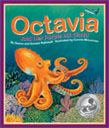
Octavia and her Purple Ink Cloud
Octavia Octopus and her sea-animal friends love playing camouflage games to practice how they would hide from a “big, hungry creature.” Octavia, however, just cannot seem to get her colors right when she tries to shoot her purple ink cloud. What happens when the big, hungry shark shows up looking for his dinner? This creative book introduces basic colors along with the camouflage techniques of various sea animals; a great introduction to marine biology!
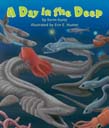 A Day in the Deep
A Day in the Deep
Travel deep into the ocean way below the surface and you’ll encounter some creatures you never knew existed! This book takes you on a journey through the dark depths of the sea towards the ocean floor. Most ecosystems need sunlight, but deep in the ocean where the sun doesn’t shine animals have adapted some very interesting ways to see, protect themselves, and eat. Discover the unique habitats, adaptations, and food chains of these deep -sea creatures.
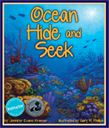 Ocean Hide and Seek
Ocean Hide and Seek
The sea is a place of mystery, where animals big and small play hide and seek! Can you imagine a shark hiding in the light? What about a clownfish in plain sight? Don’t believe it? Then, sink into the deep blue sea with Jennifer Evans Kramer and Ocean Hide and Seek! Surround yourself with the vibrant ocean illustrations of Gary R. Phillips. The ocean is an old, old place, and the exotic animals in the depths have learned to adapt to their surroundings to survive. Can you find the creatures hidden on every page? Or will you, too, be fooled by an ancient, underwater disguise?


As we continue to feature wildlife rehabilitators this month on the Sylvan Dell blog, this week we meet Kim Johnson from The Drift Inn Wildlife Sanctuary. She shares with us the trials and tribulations of rescuing wild animals.
 Texan Kim Johnson often works with her veterinarian husband and a tiny volunteer group at her Drift Inn Wildlife Sanctuary in Driftwood to care for a wide variety of mammals, including raccoons, squirrels, deer, fox, skunks, even bobcats. “Every year is different and I never know exactly what to expect” says Kim, one of a small handful of licensed rehabilitators in her state, “During Hurricane Ike, 200 squirrels were delivered to my front door.”
Texan Kim Johnson often works with her veterinarian husband and a tiny volunteer group at her Drift Inn Wildlife Sanctuary in Driftwood to care for a wide variety of mammals, including raccoons, squirrels, deer, fox, skunks, even bobcats. “Every year is different and I never know exactly what to expect” says Kim, one of a small handful of licensed rehabilitators in her state, “During Hurricane Ike, 200 squirrels were delivered to my front door.”
Despite her hectic schedule caring for wild animals, many of them babies, for 14-18 hours a day, seven days a week, Kim never seems to lose her sense of humor. “If it’s native and it lives in Texas, it’s been in my house, and maybe even if it’s not native,” she quips.
In many of the pictures that Kim submitted for possible use in Animal Helpers, she is wearing a big smile and very heavy welder’s gloves. The grin is, of course, because Kim loves her job. The gloves are because she is smart and seasoned. After 33 years as a rehabilitator, Kim is keenly aware that those gloves are mandatory equipment for handling fuzzy babies that have big paws, sharp teeth, and claws.
Name: Kim Johnson
Name of organization/clinic: The Drift Inn Wildlife Sanctuary
State: Texas
Specialty/special areas of experience: Mammals, raptors
Years as rehabilitator/volunteer: 33 years
Busiest time of year: May-July
Number of hours you work per week during your busy season: 18+ hours a day 7 days a week
Number of volunteers in clinic: 4
Why did you become a rehabilitator/volunteer: For the love of nature and animals
Most rewarding aspect of rehabilitation: Release days and seeing an animal we thought would not pull through survive and be released!
 As a rehabilitator, what is the most common question you are asked? If I touched it, will the mother come back?
As a rehabilitator, what is the most common question you are asked? If I touched it, will the mother come back?
Having cared for wildlife for so long, Kim cheerfully tells wonderful stories about the creatures that have come through her clinic, such as: A 7-week-old bobcat came to us on Christmas Day. He was cute as a button, cute in the “I have claws and teeth and know how to use them” kind of way. For some reason, people still think that all little wild animals drink cow’s milk. (Unless they arecows, they do not do well on cow’s milk.) After getting his weight up, this bobcat soon started to fit right in with the rest of the crew. He ate mice in nanoseconds, soon was jumping up on everything and getting more mischievous by the day! Seven weeks later, it was time to move him to a larger facility. This bobcat had grown four times the size he was when we got him. He was ready to mingle with his own kind. We transferred him to a much larger facility outside of San Antonio where there are 12 other bobcats. He will be released onto a 1,000 plus acre refuge. We will miss him; but, as with all of our animals, we feel blessed to have them and to be able to give them the care they need for the time we do.
Favorite animal story: We got a call that an adult raccoon had his head stuck for the entire night and half of the day in a bird feeder in a tree. As I got there sure enough, he had wedged himself to where he could rest on the edge of the feeder as he contemplated his problems. I told the lady that I could save the coon but not the feeder. She suggested that they have a warning for purchasers of said bird feeder that it could also capture raccoons. I got on a ladder and proceeded to unscrew the feeder and remove it from the tree. So far so good. I quickly realized that the coon was not coming out of the feeder without a chisel or saw and some serious drugs (for the coon of course). I decided to put said coon and feeder in the back of the SUV and take him the eight miles down the road to the house where Dr. Johnson (Ray) could tranquilize him and we could then figure out how to release the raccoon from his feeder. Halfway home, I have visions of the coon releasing himself from the feeder and kicking my tail in the car all the way home. Luckily, for both of us he was quite stuck and we made it home. Ray was almost laughing too hard to sedate the bugger but we got it done and although he never completely passed out, he was docile enough to unscrew the rest of the feeder and chisel the wood from around his neck without so much as a scratch on him! He looked at us and groggily ran off without so much as a thank you.
What advice would you offer to children considering a career in wildlife rehabilitation?
Become a veterinarian who specializes in wildlife. There are few out there and more are needed!
 Remember Animal Helpers: Wildlife Rehabilitators is FREE for the month of October at www.sylvandellpublishing.com, or Read it on your iPad, by downloading the free app Fun eReader in iTunes and entering the code: 2WZ637 in the red box on the App Registration page.
Remember Animal Helpers: Wildlife Rehabilitators is FREE for the month of October at www.sylvandellpublishing.com, or Read it on your iPad, by downloading the free app Fun eReader in iTunes and entering the code: 2WZ637 in the red box on the App Registration page.



The Junior Master Gardener Program and the American Horticultural Society announced the winners of the "Growing Good Kids" Book Awards on July 20th. This year's blue-ribbon crop is as follows:
The Mangrove Tree: Planting Trees to Feed Families, by Susan L. Roth & Cindy Trumbore (Lee & Low)
Meadowlands: A Wetlands Survival Story, by Thomas F. Yerzerski (Farrar, Straus and Giroux)
Planting the Wild Garden, written by Kathryn O. Galbraith and illustrated by Wendy Anderson Halperin (Peachtree)
For more information about the prizes, which honor "engaging, inspiring works of plant, garden, and ecology-themed children's literature," go to the Junior Master Gardener website. Don't miss the list of classics, which includes Miss Rumphius, The Lorax, Too Many Pumpkins, among many others.
By:
Administrator,
on 3/7/2012
Blog:
Margo Dill's Read These Books and Use Them!
(
Login to Add to MyJacketFlap)
JacketFlap tags:
bullying,
science books,
Journal Writing,
Middle Grade Novel,
Cause and Effect,
Reading Skills,
Middle School Teachers,
Book Giveaway Contest,
Elementary Educators,
Books with Science Content,
Making Personal Connections,
contemporary novel,
Book Club Possibility,
Zydek Heather,
death of mother,
Add a tag
 I am excited to be giving away Stranger Moon and doing it with Rafflecopter for the first time! I would love it if you tried out Rafflecopter with me by doing as many of the tasks as you can below and then getting all the possible points to win this AWESOME book. The contest goes until Sunday, March 11 at midnight (so enter on Saturday or before), and it is open to anyone–(Canada and U.S.–you can get a hard copy; overseas–you can get an e-book). So, here we go. . .
I am excited to be giving away Stranger Moon and doing it with Rafflecopter for the first time! I would love it if you tried out Rafflecopter with me by doing as many of the tasks as you can below and then getting all the possible points to win this AWESOME book. The contest goes until Sunday, March 11 at midnight (so enter on Saturday or before), and it is open to anyone–(Canada and U.S.–you can get a hard copy; overseas–you can get an e-book). So, here we go. . .
Stranger Moon by Heather Zydek
*Middle-grade novel, contemporary fiction
*12-year-old girl as main character
*Rating: I loved Stranger Moon! I think middle-grade readers will, too. It has several boy characters that are friends with Gaia, and it has bugs (LOL), so I think it will appeal to both boys and girls. If you have a child being bullied, this book is great conversation starter.
Short, short summary: It’s summer break, and Gaia is searching for a Luna moth after she finds a Luna moth wing pressed between the pages of an old insect guide. When she convinces her friends to go with her to search for the moth, they encounter a strange woman in the woods who EATS bugs. She freaks them out, of course, but she also peaks their interest, and they go on a hunt to find out whom she is. In the meantime, they pick up another misunderstood classmate, encounter the bullies– THE EMMAS, and deal with their own issues. Gaia has a father who pays NO ATTENTION to her since her mother died, and she is tired of feeling like she’s invisible in her own home. So, as you can see, there’s a lot going on in this book. As more information is revealed about the mystery woman, readers can try to guess her identity. Once it’s discovered, they can debate what they would do with the info. The author does a great job of moving the story forward and tying up all these subplots in the end.
So, what do I do with this book?
1. This is a terrific book to open up conversations with children about how they are feeling at home, about bullying, about friendships, and so on. Use the characters in the book. How did you feel when Gaia and her friends got into the big fight? What do you think about the Emmas? and so on.
2. Your young readers may or may not be into insects. If they are, then ask them to find out about Luna moths on their own. If they aren’t, what are they passionate about? What would they spend their summer vacation searching for? Have them write a journal entry about this and compare themselves to Gaia.
3. The characters in this book are complex and well-developed–they are perfect for character studies. You could teach character motivation, character feelings, and even problem-solving (how characters solve problems in the story). Allow students to choose their favorite character and then write a letter as if they are that character. They could also write a journal entry.
Don’t forget to enter the giveaway below! Please email margo (at) margodill.com if you run into any problems.
a Rafflecopter giveaway
You need javascript enabled to see this giveaway.
The Children's and Young Adult Bloggers' Literary Awards (the Cybils) were announced on February 14th. You'll lots of good reading in a variety of categories, from book apps to young adult fiction.
The American Association for the Advancement of Science recently announced the winners of the AAAS/Suburu Science Books & Film Prize for Excellence in Science Books. The prize honors books for children. You'll see only the winners on the AAAS site. The list of finalists is accessible only to subscribers of Science magazine.
With all the interest in school and community gardens these days, the list of "Growing Good Kids" book awards is a wonderful resource. The latest winners, announced last weekend, are as follows. (Don't miss the roster of classics, too.)
 Water, Weed and Wait, written by Edith Hope Fine and Angela Demos Halpin; illustrated by Colleen Madden (Tricycle Press, 2010)
Water, Weed and Wait, written by Edith Hope Fine and Angela Demos Halpin; illustrated by Colleen Madden (Tricycle Press, 2010)
Nibbles: A Green Tale, by Charlotte Middleton (Marshall Cavendish, 2010)
In the Garden with Dr. Carver, written by Susan Grigsby and illustrated by Nicole Tadgell (Albert Whitman & Company, 2010)
A description from the American Horticultural Society:
The Junior Master Gardener Program and the American Horticultural Society honor engaging, inspiring works of plant, garden and ecology-themed children's literature through the new "Growing Good Kids—Excellence in Children's Literature Awards" Program.
This award recognizes a select group of children's books that are especially effective at promoting an understanding of and appreciation for gardening and the environment.
You'll find additional children's book titles about gardening today at A Year of Reading. That post inspired this one. Thanks, Franki and Mary Lee.
 Susan Wyndham, the literary editor of the Sydney Morning Herald, compiled a list of ''15 Australian books - and some extra suggestions - that every Australian can enjoy if they want to understand our literature, our country and ourselves. Culture is a conversation and knowing these books enables us to talk to each other." You can read Wyndham's list here.
Susan Wyndham, the literary editor of the Sydney Morning Herald, compiled a list of ''15 Australian books - and some extra suggestions - that every Australian can enjoy if they want to understand our literature, our country and ourselves. Culture is a conversation and knowing these books enables us to talk to each other." You can read Wyndham's list here.
As a followup to Wyndham's list, journalist and children's book expert Judith Ridge rounds up the "15 Australian picture books that everyone should know." She's planning to do the same for middle-grade and YA books, too. Ridge writes, "It is a list that, if you read them all, would go some way towards an understanding of. [...] the preoccupations Australian children's literature, and what those preoccupations say about Australian childhood and adolescence (or perhaps our adult perceptions of and ideas about Australian childhood and adolescence)."
The prolific children's book author Dick King-Smith died earlier this week. King-Smith's book The Sheep-Pig (published in the U.S. as Babe: The Gallant Pig) was the basis for the movie "Babe." Obituary at the Guardian. (news via @pwkidsbookshelf)
Jason Wallace's debut novel, Out of Shadows, won the UK's Costa Children's Book Award. The Herald Scotland reports that Out of Shadows, based on the author's experiences in post-independence Zimbabwe, was turned down by more than 100 agents and publishers before Andersen Press picked it up. The book will be published stateside by Holiday House in April.
Back to the States, Rita Williams-Garcia's middle-grade novel One Crazy Summer has won the Scott O'Dell Award for Historical Fiction. Details at Read Roger, the blog of The Horn Book's editor, Roger Sutton.
Will One Crazy Summer go on to win the Newbery? We'll see soon. The Newbery, Caldecott, Coretta Scott King, etc., are announced on Monday morning, January 10th. The American Library Association provides more information.
Speaking of the Coretta Scott King Award, author Kyra E. Hicks offers some thoughts on potential winners of the prize for "outstanding books for young adults and children by African American authors and illustrators that reflect the African American experience." See Hicks' blog,
In the car
An unabridged audiobook of Charlie and the Chocolate Factory, by Roald Dahl (HarperChildren's Audio, 2005). Monty Python's Eric Idle is the narrator. It had been a long time since I read this one, but I remember Charlie's yearning as he breathed in the delicious chocolate aroma on the way to school. I'd forgotten how insane the Oompa-Loompas' songs are.
We're on the hold list for Harry Potter and the Chamber of Secrets (Random House Audio, 1999). Audiobooks have proved to be an ideal remedy for people (like me) who get fidgety/impatient/insanely bored in the car.
Junior, age 11
Diary of a Wimpy Kid: The Ugly Truth, by Jeff Kinney (Amulet Books, 2010). The latest in the popular series.
Controlling Earth's Pollutants, by Christine Petersen (Marshall Cavendish, 2010). An ideal hour of reading for the kiddo: cocoa, blanket, cozy chair, and a book on pollution.
On the nightstand is Nic Bishop Lizards (Scholastic, 2010). Fantastic photos, per usual with Bishop. "Lizards lead lives that are full of surprises." Yeah.
Read-aloud
In the Wild, a picture book written by David Elliott and illustrated by Holly Meade (Candlewick, 2010). Poems about wild animals. Sheesh, this is a beautiful book, with its watercolored woodcuts and all. I asked my son to vet this one for the second grade class I read to. He thought they'd like it.
Pop! The Invention of Bubble Gum, by Meghan McCarthy (Paula Wiseman/Simon& Schuster, 2010). We're thinking the second graders will like this one, too. Great idea for a nonfiction picture book.
Me
Lots of Cybils middle grade/YA nonfiction books, including The Dark Game: True Spy Stories, by Paul B. Janeczko (Candlewick, 2010). Two of the most famous Civil War spies were women. I never knew that.
Second-grade class read-aloud
Lousy Rotten Stinkin' Grapes, written by Margie Palatini and illustrated by Barry Moser (Simon & Schuster, 2009). A new take on the Aesop fable. Very funny, with priceless expressions on the animals' faces. The class loved it. Now, clearly, we must get a hold of Palatini and Moser's Earthquack! (Simon & Schuster, 2002).
 International Rock Flipping Day is Sunday, September 20th. Turn over a rock, see and identify what's under it, and write a blog post or submit a Flickr set of photos. (And put the rock right back where you found it.) It sounds like something a six year old invented, but the credit goes to several grown-up nature enthusiasts, including one "doyenne of invertebrate bloggers." You'll find more information at Wanderin' Weeta, a nature blog.
International Rock Flipping Day is Sunday, September 20th. Turn over a rock, see and identify what's under it, and write a blog post or submit a Flickr set of photos. (And put the rock right back where you found it.) It sounds like something a six year old invented, but the credit goes to several grown-up nature enthusiasts, including one "doyenne of invertebrate bloggers." You'll find more information at Wanderin' Weeta, a nature blog.
Junior and I participated last year and found Asian shore crabs, mussels, and clams under rocks at the beach. See this report from September '08.
Dave Bronta, a flip-day founder who blogs at Via Negativa, wrote, "[P]eople flipped rocks on four continents on sites ranging from mountaintops to urban centers to the floors of shallow seas. Rock-flippers found frogs, snakes, and invertebrates of every description, as well as fossils and other cool stuff. As before, we advise wearing gloves for protection, and getting the whole family involved — or if you don’t have a family, rope in some neighborhood kids."
Five, six, and seven year olds interested in the rocks themselves might like Nancy Elizabeth Wallace's Rocks! Rocks! Rocks! (Marshall Cavendish Children's Books, 2009), a picture book that introduces concepts about rock formation and other topics in simple language. (I wish the author hadn't cutely called igneous rocks "iggy," but I doubt kids will care.)
For more in-depth reading, older children can look for National Audubon Society First Field Guide to Rocks and Minerals (Scholastic, 1998).
Review copy of Rocks! Rocks! Rocks! provided by the publisher. The Audubon Society field guide from our home collection.
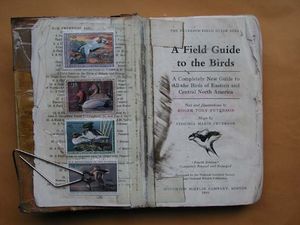 When I read Hank Golet's story on the Connecticut Ornithological Association's email list, I knew it was the perfect intro to a blog post about field guides and other nature-related gifts. Hank kindly gave me permission to reprint the tale here. (Note: Roger Tory Peterson [1908-1966] invented the modern field guide; he lived in Connecticut for many years.)
When I read Hank Golet's story on the Connecticut Ornithological Association's email list, I knew it was the perfect intro to a blog post about field guides and other nature-related gifts. Hank kindly gave me permission to reprint the tale here. (Note: Roger Tory Peterson [1908-1966] invented the modern field guide; he lived in Connecticut for many years.)
Reading [another birder's] lost Peterson Field Guide story reminded me of one of my own experiences.
I was birding at Menunketesuck flats in Westbrook, probably 20 years ago, and left my signed Peterson Guide on the seawall. I didn't know it was missing until I reached for it two days later, and found it wasn't in the wooden box behind the seat in my pickup. Somehow I remembered putting it on the wall and drove down to Westbrook never expecting it to still be there. The guide was where I left it...but I didn't mention that it rained all of the day before. I took the book home and put paper towels between every page to dry it out the best I could but it still had/has that "expanded" look.
Peterson always signed his works with a red soft pen that was not waterproof. His signature had faded badly in my guide but it was still readable. Roger and his wife Virginia used to like to come down to the dock at the end of the road where I live here in Old Lyme. One early evening I was there when they came down. I showed him the guide and told him the story of my leaving it on the seawall and asked him if he would sign it again. He did but he didn't have his red pen so he signed it with my black ballpoint.
So, I may have the only Peterson field guide signed twice, once in red and, right underneath, in black.
Besides that, I probably have the only Peterson Guide (the same one) that has a black tire mark across the third page in, from when the bag that I was carrying it in came off the back of my motorcycle on I-95 and the car behind me ran over it.
Following are some resources for finding an equally stalwart book for naturalists young and old.
Luke Tiller's Under Clear Skies, a top-notch birding blog, recently posted about holiday gifts for birders; some of the DVDs mentioned would be great for children. Plus, Luke has a few other ideas for kids, too.
At Scientist, Interrupted, GrrlScientist points out some cool new natural-history books—many of them kid-friendly—including a pop-up affair with sound called Birdscapes and a graphic novel about Darwin. She also reviews a nonfiction title for adults, Dry Storeroom #1: The Secret Life of the Natural History Museum, "a charming and affectionate tour through the the inner workings and
politics of London's Natural History Museum by paleontologist and
trilobite expert Richard Fortey." And for children, Grrl Scientist gives high marks to Sparrows, a picture book.
The 10,000 birds blog maintains a wonderful archive of reviews of books and equipment. The Birder's Library has a lovely list of books for children, and 100 Scope Notes' consideration of Animals: A Visual Encyclopedia makes that one sound like a good holiday present for young nature-lovers.
Finally, don't miss the American Association for the Advancement of Science (AAAS) top science books for children and teens (finalists for the AAAS/Suburu SB&F Prize for Excellence in Science Books).
Happy reading! Many thanks to Hank Golet for his contribution.
Photograph by Hank Golet. All rights reserved.
 Last week I posted a bit from scientist Edward O. Wilson's memoir, Naturalist. A blog entry by tech writer David Pogue reminded me that Wilson is the "father" of the enormous online project called the Encyclopedia of Life. Here is an excerpt from an interview with Wilson. In answer to a question about how the EOL project came to be, Wilson said,
Last week I posted a bit from scientist Edward O. Wilson's memoir, Naturalist. A blog entry by tech writer David Pogue reminded me that Wilson is the "father" of the enormous online project called the Encyclopedia of Life. Here is an excerpt from an interview with Wilson. In answer to a question about how the EOL project came to be, Wilson said,
Because remarkably–and this is little known even in the scientific
community–we’ve only begun to explore this planet. It was 250 years ago
this year that Karl Linnaeus, the great naturalist in Sweden, began what
became the official form of biological classification: two names, like
“homo sapiens” for us, and ranging the species in hierarchies according to how much they resemble one another. 250 years ago.
And in that period of time, we have found and given names to perhaps
one-tenth of what’s on the surface of the earth. We have now found 1.8
million species. But the actual number is almost certainly in excess of
10 million, and could be as high as a hundred million, when you throw
in bacteria.
I love what this means for scientifically oriented children when they grow up—there's so much out there, waiting for them to discover. Of course, one of Wilson's main points is that we all have to work hard to protect our world, too.
Naturalist quickly leaped to the top my list of favorite books read lately. I especially enjoyed the parts about his peripatetic childhood in the South. He even spent a year at military school—when he was only 7. What he wrote about his Harvard colleague James Watson, one of the discoverers of DNA and "the most unpleasant human being [Wilson] had ever met", made me want to read more about that scientist, too.
Speaking of just beginning to explore the planet, the kiddo and I paged through Tony Waltham's Great Caves of the World (Firefly Books, 2008), mostly just looking at the photographs and noting where we'd like to visit. New Mexico, for sure, to see Carlsbad Caverns. If we were scientists or National Park management, we could get into the awesome-looking Lechuguilla Cave, in the same area. (See photo.)
The farther-flung caves under Australia's Nullarbor Desert also caught our eye. Waltham writes, "The Nullarbor has hundreds of blowholes, nearly all too small to enter. Some link to known caves, but others merely indicate that there is a lot more cave passage still to be discovered beneath the Australian desert." A similar theme to Wilson's.
Like Great Caves, Edward O. Wilson's Naturalist is a book written for adults, but would be fine for older teenagers who like science. The next time I'm at the library, I'll look for The Earth Dwellers: Adventures in the Land of Ants, by Erich Hoyt (Simon and Schuster, 1996), a YA nonfiction book about Wilson and others. I'm unable to find a picture-book or middle-grade biography of the scientist. Anyone know of one? An opportunity for a writer, perhaps.
Photograph: Lechuguilla Cave Pearlsian Gulf, by Dave Bunnell. Used under the conditions specified by a Creative Commons Attribution- Share Alike 2.5 license.
The official announcement has been made over here, at the Cybils blog. You can find the remaining short lists up today, too, including Nonfiction Picture Books, one of our family's favorite categories.
In alphabetical order:
Marie Curie (volume 4 in the Giants of Science series) by Kathleen Krull, illustrated by Boris Kulikov; Krull's Isaac Newton made it to last year's short list
Viking Juvenile
The Periodic Table: Elements With Style! created (and illustrated) by (Simon) Basher, written by Adrian Dingle
Kingfisher
Smart-Opedia: The Amazing Book About Everything, translated by Eve Drobot
Maple Tree Press
Tasting the Sky: a Palestinian Childhood by Ibtisam Barakat
Farrar, Straus and Giroux
Tracking Trash: Flotsam, Jetsam, and the Science of Ocean Motion (from the Scientists in the Field series) by Loree Griffin Burns
Houghton Mifflin
The Wall: Growing Up Behind the Iron Curtain by Peter Sís
Farrar, Straus and Giroux
Who Was First?: Discovering the Americas by Russell Freedman (whose Freedom Walkers won this category last year)
Clarion
Getting down to brass tacks now is the Judging Panel, comprised of
Tracy Chrenka at Talking in the Library
Emily Mitchell at Emily Reads
Camille Powell at Book Moot
Alice Herold at Big A little a
Jennie Rothschild at Biblio File
* * *
It was a wild ride. Five panelists, one newborn baby, a couple of holidays over several months, and 45 nominated children's nonfiction books published in 2007 -- on the subjects of history, science, mathematics, reference, biography, memoirs, humor, how to, essays, popular culture, music, and more. Much more.
What an absolute delight to work on the MG/YA nonfiction nominating panel alongside Susan at Chicken Spaghetti, Vivian at HipWriterMama, Mindy at Proper Noun Dot Net, and KT at Worth the Trip, all under the leadership of master wrangler and organizer Jen Robinson. The other panelists made the job of distilling the 45 nominated titles down to seven as easy as possible under the circumstances, and I continue to be amazed at how smoothly our negotiations and jockeyings went. Thank you each, thank you all for several marvelous months.
While we had a fraction of the books some of the other panels had to read (though more than I had to deal with last year on the poetry panel), our hunting and gathering skills were put to work tracking down titles for which review copies weren't furnished. So I'd also like to thank the patient and quick-working libraries in our system that sped books to me, often shortly after processing. And lastly, a big thanks to my kids, who put up with a good deal of questioning, poking, and prodding about what they liked and didn't about the the books they read, with and without me.
And special thanks, again, to Anne Boles Levy and Kelly Herold for coming up with the idea of the Cybils and organizing everything.
One of the reasons I wanted to serve on this particular panel is that for our family, and so many other home school families we know, high quality nonfiction titles are the backbone of our curricula, as well as our some of our children's favorite free-time reading. I wanted, through the Cybils, to be able to publicize some of the best of the bunch, so you and your kids can include these new gems on your "to read" lists.
The other reason is that I realize, sadly, that for many non-home schooling families, nonfiction children's titles are considered the second rate, second tier, B List, utility grade, inferior choice when it comes to children's books, and I wanted to be able to use an opportunity like the Cybils, with such a terrific short list of books of marvelous depth and range, to show that children's nonfiction is not only chock full of superior choices, but every inch the equal of fiction.
I'd like to encourage other readers and fans of children's nonfiction, especially those who are concerned about what children's nonfiction author Marc Aronson calls "nonfiction resistance", to keep up with the subject on Marc's blog, Nonfiction Matters
And one final note -- a raft of terrific children's 2007 nonfiction titles didn't make it to the list of nominees to be considered for the above short list. If your favorite wasn't nominated, it's because you didn't speak up for it. Don't let that happen next year.
 There were no science books on the YALSA Award for Excellence in Nonfiction for 2016. Nor in 2015. Nor 2014. Bomb in 2013 was sort of a science book, so we’ll count that. And Moonbird that year certainly was. Yet it’s often surprising how consistently science and nature get overlooked when they’re handing out awards for nonfiction. According to my sources, science writers are complaining about this fact, and with good reason. When you create an award for nonfiction and then hand it consistently to biographies, you are, however unintentionally, sending a message.
There were no science books on the YALSA Award for Excellence in Nonfiction for 2016. Nor in 2015. Nor 2014. Bomb in 2013 was sort of a science book, so we’ll count that. And Moonbird that year certainly was. Yet it’s often surprising how consistently science and nature get overlooked when they’re handing out awards for nonfiction. According to my sources, science writers are complaining about this fact, and with good reason. When you create an award for nonfiction and then hand it consistently to biographies, you are, however unintentionally, sending a message.






































 As the sun begins to set, arctic animals scurry to prepare for six months of darkness and cold. Tuktuk the collared lemming is almost ready for the long winter night – all he needs is warm fur to line his nest. When one furry kamik (boot) slips off an Inuit driver’s sled, Tuktuk is in luck! But as he drags it home, Putak the polar bear, Aput the arctic fox, and Masak the caribou eye this little lemming’s prize and want it for their own. Can Tuktuk outwit the other animals and convince them that one furry kamik is no good for anyone bigger than a lemming?
As the sun begins to set, arctic animals scurry to prepare for six months of darkness and cold. Tuktuk the collared lemming is almost ready for the long winter night – all he needs is warm fur to line his nest. When one furry kamik (boot) slips off an Inuit driver’s sled, Tuktuk is in luck! But as he drags it home, Putak the polar bear, Aput the arctic fox, and Masak the caribou eye this little lemming’s prize and want it for their own. Can Tuktuk outwit the other animals and convince them that one furry kamik is no good for anyone bigger than a lemming? Little Woolly leaves her mother behind as she chases a toad down to the river. When the glacial ice breaks, she is swept away in the rumbling, rolling water. Now alone, the mammoth calf struggles to survive. She must sneak past cave lions, bears, saber-toothed cats and humans. Exhausted and afraid, she must even hide from stormy weather as she fights her way back to her herd. How can she find them? Will she ever get back?
Little Woolly leaves her mother behind as she chases a toad down to the river. When the glacial ice breaks, she is swept away in the rumbling, rolling water. Now alone, the mammoth calf struggles to survive. She must sneak past cave lions, bears, saber-toothed cats and humans. Exhausted and afraid, she must even hide from stormy weather as she fights her way back to her herd. How can she find them? Will she ever get back? Dangerous animals from all over the world gather for the Most Dangerous Animal of All Contest. Snakes, spiders, sharks . . . who will the winner be? Deadly poison, huge teeth, razor -sharp horns, and fearsome feet are just a few of the ways that animals kill. Predators mean to kill. Prey simply defend themselves. And yet, the unexpected most deadly-animal doesn’t mean to harm at all!
Dangerous animals from all over the world gather for the Most Dangerous Animal of All Contest. Snakes, spiders, sharks . . . who will the winner be? Deadly poison, huge teeth, razor -sharp horns, and fearsome feet are just a few of the ways that animals kill. Predators mean to kill. Prey simply defend themselves. And yet, the unexpected most deadly-animal doesn’t mean to harm at all! Someone stole a cake from the cake contest—who could it be? Twelve animal bakers are potential suspects but Detective Duck uses his deductive reasoning skills to “quack” the case. After all, the thief left hairs behind so the thief wasn’t a bird. Follow along as he subtracts each suspect one at a time to reveal just who the culprit was. This clever story will have children of all ages giggling at the puns and the play on words. Key phrases for educators: subtraction, deductive reasoning, animal adaptations, puns/play on words.
Someone stole a cake from the cake contest—who could it be? Twelve animal bakers are potential suspects but Detective Duck uses his deductive reasoning skills to “quack” the case. After all, the thief left hairs behind so the thief wasn’t a bird. Follow along as he subtracts each suspect one at a time to reveal just who the culprit was. This clever story will have children of all ages giggling at the puns and the play on words. Key phrases for educators: subtraction, deductive reasoning, animal adaptations, puns/play on words. Imaginations will soar from the forest floor, up through the canopy and back down again, following the circle of life. The jungle comes alive as children learn about the wide variety of creatures lurking in the lush Amazon rainforest in this clever adaptation of the song “The Green Grass Grew All Around.” Search each page to find unique rainforest bugs and butterflies hiding in the illustrations. Delve even deeper into the jungle using sidebars and the “For Creative Minds” educational section, both filled with fun facts about the plants and animals, how they live in the rainforest and the products we use that come from the rainforest.
Imaginations will soar from the forest floor, up through the canopy and back down again, following the circle of life. The jungle comes alive as children learn about the wide variety of creatures lurking in the lush Amazon rainforest in this clever adaptation of the song “The Green Grass Grew All Around.” Search each page to find unique rainforest bugs and butterflies hiding in the illustrations. Delve even deeper into the jungle using sidebars and the “For Creative Minds” educational section, both filled with fun facts about the plants and animals, how they live in the rainforest and the products we use that come from the rainforest. From the “crocodile’s dentist,” to the “mongoose spa,” Animal Partners takes a whimsical look at symbiotic relationships of animals large and small. Although many animals live in groups of the same kind, here you will learn how some animals form unique partnerships with different species. After all, don’t we all need a little help from our friends?
From the “crocodile’s dentist,” to the “mongoose spa,” Animal Partners takes a whimsical look at symbiotic relationships of animals large and small. Although many animals live in groups of the same kind, here you will learn how some animals form unique partnerships with different species. After all, don’t we all need a little help from our friends?










THEY ALL SAW A CAT is also a fabulous book for science discussions, since it is about the different ways animals perceive the world around them. Okay, maybe it isn’t one of those books with a lot of back-matter to answer questions, but it generates questions like crazy, and inquiry is the essence of science, n’est ce pas?
I have loved these lists! They have been like the best Advent calendar ever! Thank you for doing them.
Thank you so much for including Coyote Moon on this list, Betsy!! What a thrill to see it here, and a nice holiday present :).
I also loved The Tragic Tale of the Great Auk, and it made me weep (though granted these days I am far more weepier than normal). It is tragic indeed! And I hadn’t heard of Deep Roots–I will look for it, and the others that I haven’t yet read from your list (I’ve read 19 of theses :).)
I do love PB bios, but it would be great to see sciency-book get book award nods too.
Hmmm. Stretching it but tis the season. I’ll give it to you!
What a great list! There are several titles here that I haven’t read yet and can’t wait to get my hands on.